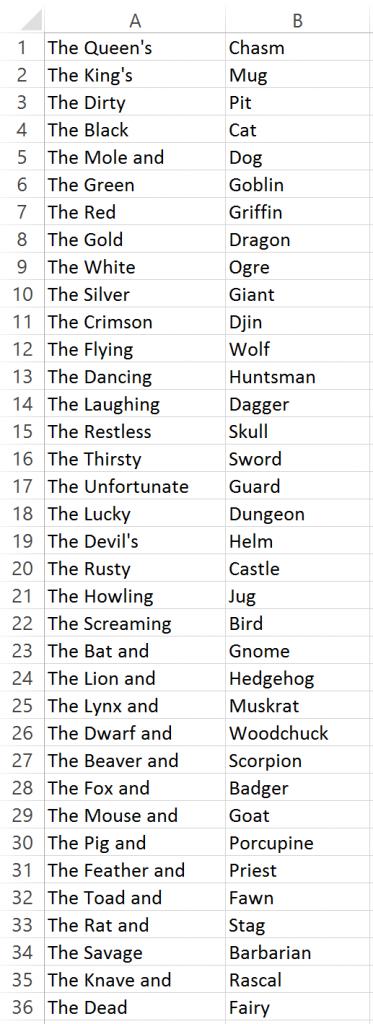One of Daggerfall’s long-running puzzles is how to generate the correct building name for any given building in a location. Daggerfall’s binary data exposes this information only as a seed value with no obvious correlation to the final name. From today, I’m happy to say this has been solved and I will be able to generate proper building names in the future. This article is a summary of the technical journey, minus all the dead ends and frustration.
The seed value used to generate building names has been known about for some time. This can be found in the BuildingData structure (link to UESP). The first step along the way was to generate some known values by changing a known seed value in MAPS.BSA. I started at the location Ashfield Hall in the Daggerfall province, which has a single tavern and some residences. Taverns are a great place to start as they have a very obvious PartA + PartB structure. For example The Bat And Skull. In Ashfield Hall, our single tavern is the The Howling Stag with a name seed value of 27748.
The first thing I did was change the name seed value for The Howling Stag in MAPS.BSA then start up Daggerfall to see how the name changes. Here’s a small sample of names generated from seeds 0-3. Keep this list in mind as we’ll return to it later.
0 = The Dancing Chasm 1 = The Knave and Scorpian 2 = The Pig and Ogre 3 = The Thirsty Fairy
Now I have somewhere to begin. I know the building is a tavern and have a sample group of seeds that result in specific names. The next trick is to work out how Daggerfall derives these names from the seed value.
I open up FALL.EXE in a hex viewer and search through for strings like “The Dancing” and “Chasm”. These strings are easy enough to locate, but these are just resources packed into the executable. What I need is the actual PartA and PartB tables Daggerfall is selecting from at runtime.
To get this information, I first have to use the DOSBox debugger to dump out memory from Daggerfall while it’s running. I can then search not just for strings, but for memory offsets pointing to those strings. I write a small bit of code to do the searches for me, and it doesn’t take long to find the correct offset tables for Part A and Part B of tavern names. Just think of this as a pair of arrays. In this case, both arrays are 36 elements long. Here they are as captured from the spreadsheet I dumped them out to.

So how do we go from a seed of 0 to The Dancing Chasm? This is where most of the difficulty started. It was obvious Daggerfall used a random number generator to pick both parts, but the trick was to find the correct random number generator used by Daggerfall’s C compiler circa 1994-1996. Fortunately, I also needed this for correct texture table generation (still an open problem at time of writing) and had previously researched the correct random generator, known as a linear congruential generator, specific to Daggerfall. Here it is for completeness.
static ulong next;
public static void srand(int seed)
{
next = (uint)seed;
}
public static uint rand()
{
next = next * 1103515245 + 12345;
return ((uint)((next >> 16) & 0x7FFF));
}
There are two methods here, one to set the seed (srand) and another to generate the next random number from that seed (rand). This is pretty much the standard ANSI LCG but specific to Daggerfall’s needs. Implementing this manually ensures that critical random number generation will always work just like Daggerfall, regardless of platform.
Now that I have the right random number generator, let’s feed it our test seeds from earlier and see what comes out. Starting with seed=0 and generating two numbers (indices into Part A and Part B name tables above), I get the following results.
PartA = 0 PartB = 12
First obvious thing is the spreadsheet starts from 1, not from 0. Just need to +1 each number to match the tables above (although zero-based arrays will be used in actual code). Matching these numbers to the above name table we get: Chasm The Dancing. OK, so Daggerfall obviously generates PartB first then PartA. Let’s try that again with the +1 and order swapped.
Seed = 0 PartA = 13 (The Dancing) PartB = 1 (Chasm) Result: The Dancing Chasm
Using our handy table we can match row 13 with row 1 and we get The Dancing Chasm. Good! Let’s run some more tests and prove the concept.
Seed = 1 PartA = 35 (The Knave and) PartB = 27 (Scorpion) Result: The Knave and Scorpion Seed = 2 PartA = 30 (The Pig and) PartB = 9 (Ogre) Result: The Pig and Ogre Seed = 3 PartA = 16 (The Thirsty) PartB = 36 (Fairy) Result: The Thirsty Fairy
So far, so good! Building names are output just like Daggerfall given the same inputs. Let’s try the original, unmodified seed value of 27748 which should give us The Howling Stag.
Seed = 27748 PartA = 21 (The Howling) PartB = 33 (Stag) Result: The Howling Stag
And there we have it! Building name generation from initial seed value resulting in a string exactly matching Daggerfall.
From here, I still need to extract hard-coded name tables for other building types like armorers and weapon-smiths. This isn’t hard though, I just need to find the tables using the same methods as taverns. I also need to assign full building data from MAPS.BSA to the correct models in Unity scene and wire up API methods to query this data when inspecting or entering a building. One challenge at a time though.
For regular small updates on Daggerfall Unity, I can be found on Twitter @gav_clayton.